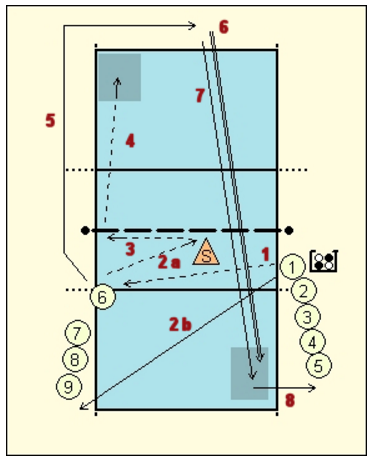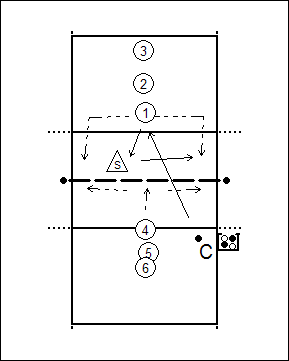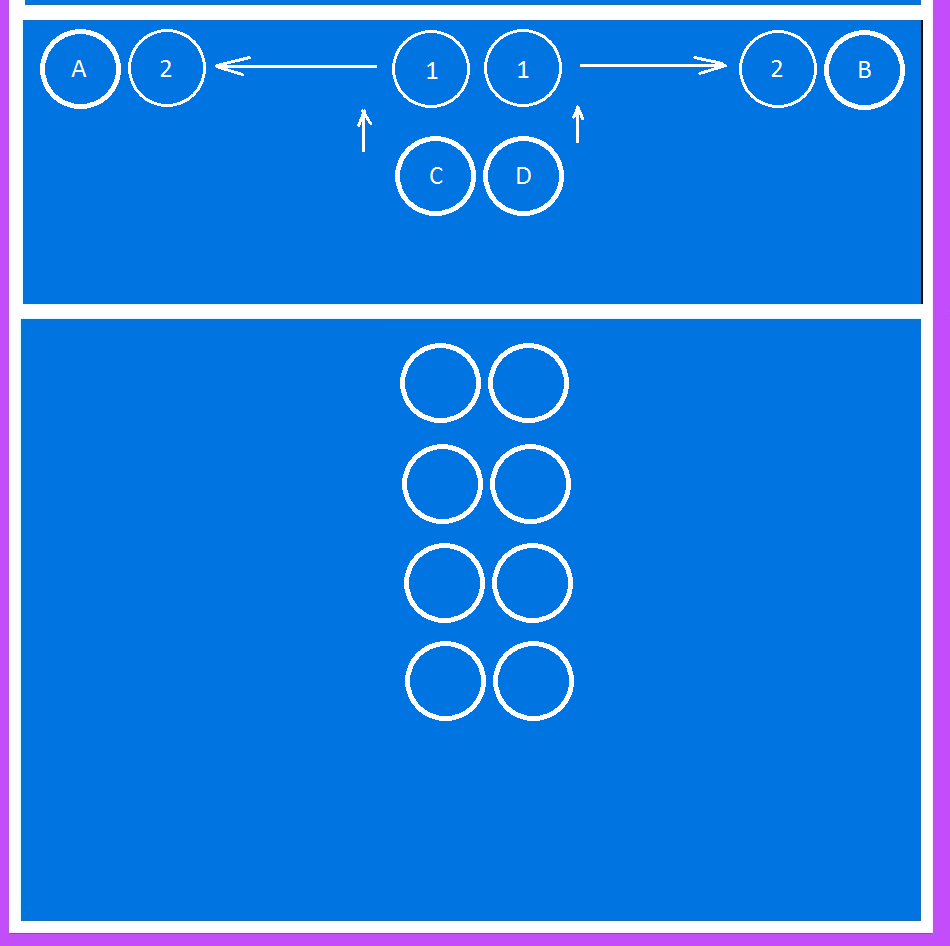Volleyball drills for technique block / net defense
- The players are in a line at position 1.
- The first makes a jump service (without ball), then runs diagonally to the net (position 4).
- Here, he/she makes a block, shuffles backwards to the 3m line, and attacks.
- Then, he/she shuffles to the middle and does the same.
- Keeps shuffling to the right and does the same here.
- Makes a dive to position 1.
Hit to outside and middle
Daarna
Beside the playmaker, the other players execute a pass, an attack, and a service.

The exercise is as follows:
- 1 Player 1 throws a tight ball to player 7
- 2a player 7 passes the ball to the playmaker
- 2b player 1 walks to the other line and joins the back.
- 3 the playmaker gives a set up to player 6
- 4 player 6 smashes the ball to the mat
- 5 player 6 picks up his own ball
- 6 player 6 serves the ball to the other mat
- 7 player 6 picks up his own ball
- 8 player 6 joins the line
- This can also be done a middle attack
After 10 minutes, a block is added
line of attackers on the 3 meter line
-C plays rally ball on attacker 1
- blocker 4 goes to the net
- 1 passes to S and calls where he wants the set up
(left, middle, or right)
- blocker follows attacker and blocks
- attacker gets ball, joins back of own line
- if the attackers score 10x, the attackers and
blockers change

- Split jump lunge is the volleyball exercise that offers a great way of strengthening glutes, quads and hips.
- So, this exercise will have a huge positive impact on your vertical jump.
- It’s worth noting that this exercise requires some balance as well as a lot of strength from a lower body.
- It’s very important for you to take the right position before starting a split jump lunge.
- You should keep your knee directly over your foot.
- On the other hand, your knee shouldn’t go over your toe.
- Then, you need to drop down into the lunge.
- Now, it’s time for you to push both your feet simultaneously and switch legs.
- Lastly, you should gently land on the floor keeping your feet wide.
- You should also raise the opposite arm of your front leg while landing.
Agreements about blocking
- Always 2 blockers on the outside
- Block left (outside) arm's length of the antenna (diagonal blocking)
- Block right (diagonal) at the antenna (straight block)
- This makes sure that position 1 (playmaker) can always be blocked, so no hard attack on position 1 is possible.
- Block middle by 1 person, block on the ball.
GOAL
Feet work for block
ORGANIZATION
Two (equal) players are across each other at the net.
EXECUTION
- A player makes a low block movement, after landing a shuffle, steps to the right and takes the ball from across the net where the other player is holding the ball. Shuffle back and transfer the ball under the net to the other player.
- Change every 5 balls
- Each 2 series of 5 taking ball over the net
- A player makes a low block movement, at landing weight more on left leg. Make a step to the right, join legs, and take the ball from other side net where the other player holds the ball up.
- Change every 5 balls
- Each 2 series of 5 taking ball over the net
It is not about the speed but about the movement and the right foot work!!
- Have 3 players walk to net, make a block jump.
- Then the players on position 3 and 4 quickly go to the 3m line, and the trainer throws a ball over the net which has to be passed to the player on position 2 (sv).
- You can still adjust by having the players first stand at the net and have them decide whether the ball should be blocked or defended.
- after the task, 3 new players in the field.
- Divide your players in pairs
- Per pair 1 ball
- One of the pair is at the net to make a block.
- the other player is on the other side of the net with a ball. This player is at the 3m line and throws the ball over the net.
- The player at the net tries to block the ball.
- 20 balls, then change tasks.
GOAL
Moving at blocking
ORGANIZATION
Two players left and right forward at net (Player position A and B). All other players in two lines after each other.
EXECUTION
- Player C and D together walk forward to the net.
- Player C and D together block at position 1.
- Player C lands after block on right leg and steps to position 2 to block A together.
- Player D lands after block on his left leg and steps to position 2 to block B together.
- C and D remain left and right forward after block, players A and B join back of line.

- make 2 lines on the 3 meter line
- from both the lines, 2 players walk forward to make a block
- then they move sidewards to the outside position
- the next player from the line moves forward and makes a block
- he also goes outside and joins the previous player
- together the make a block
- The first player joins back in the line and the second moves to the outside position
- Note: pay attention to the feet of the outside player as middle man/woman. In principle, the outside player sets the block!
- Make trios with 1 ball
- 2 players are at the net opposite each other.
- The third player has the ball, and throws it above the net rim.
- The two blockers will now duel
- Play with points and ranking within the team.
A big mistake during blocking is that players mostly watch the ball. From the moment the ball leaves the playmaker until the moment of hitting the volleyball by the attacker, the ball is watched. However, the most information can be derived from the attacker. Where is the ball going to be hit, how are the shoulders? The task is to teach the players, after they have seen which attacker is served by the playmaker, to watch the attacker.
In this exercise the trainer is standing behind the pair that forms the blocking. The trainer throws the ball over the net and the attackers hit the ball. Blocking players can no longer follow ball and they have to watch the attacker. Of course, the trainer can apply further technical improvements, such as the position of the hand, what to do after the block landing, and the way of landing
if the trainer want to keep his or her hand free to apply technical improvements while the rest of the exercise continues, the attacker can throw the ball one by one, or the playmakers.
Variations are:
1: only an outside block
2: with mid block
3: also position attackers at the mid position
It is important the players focus on the attacker.







